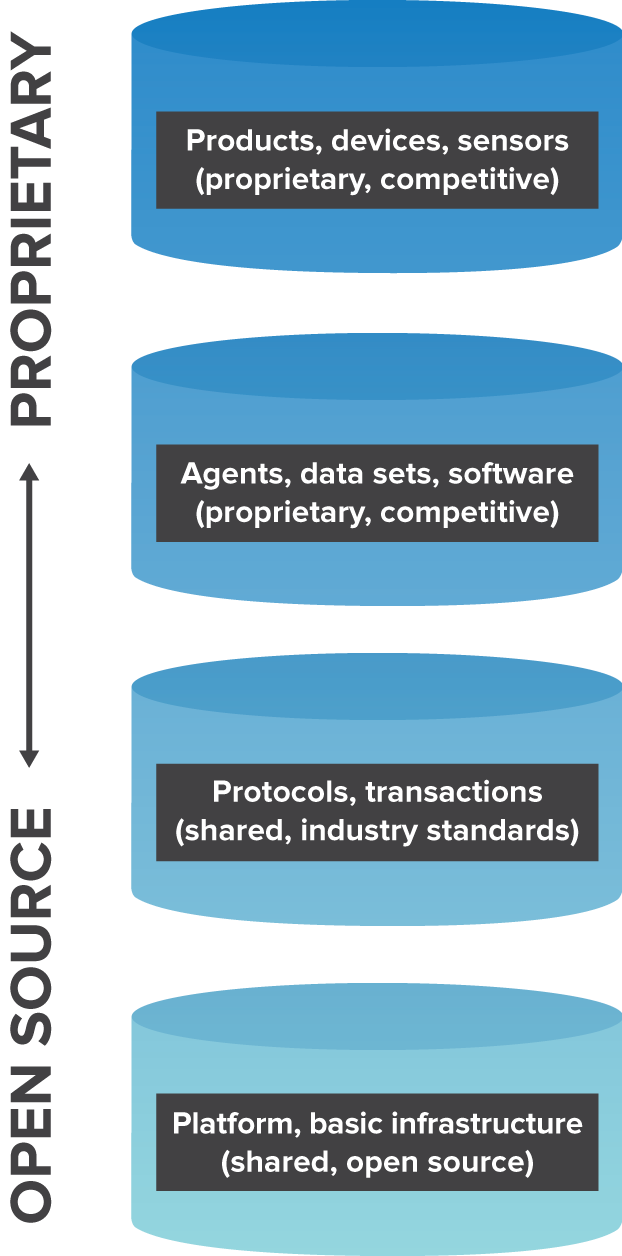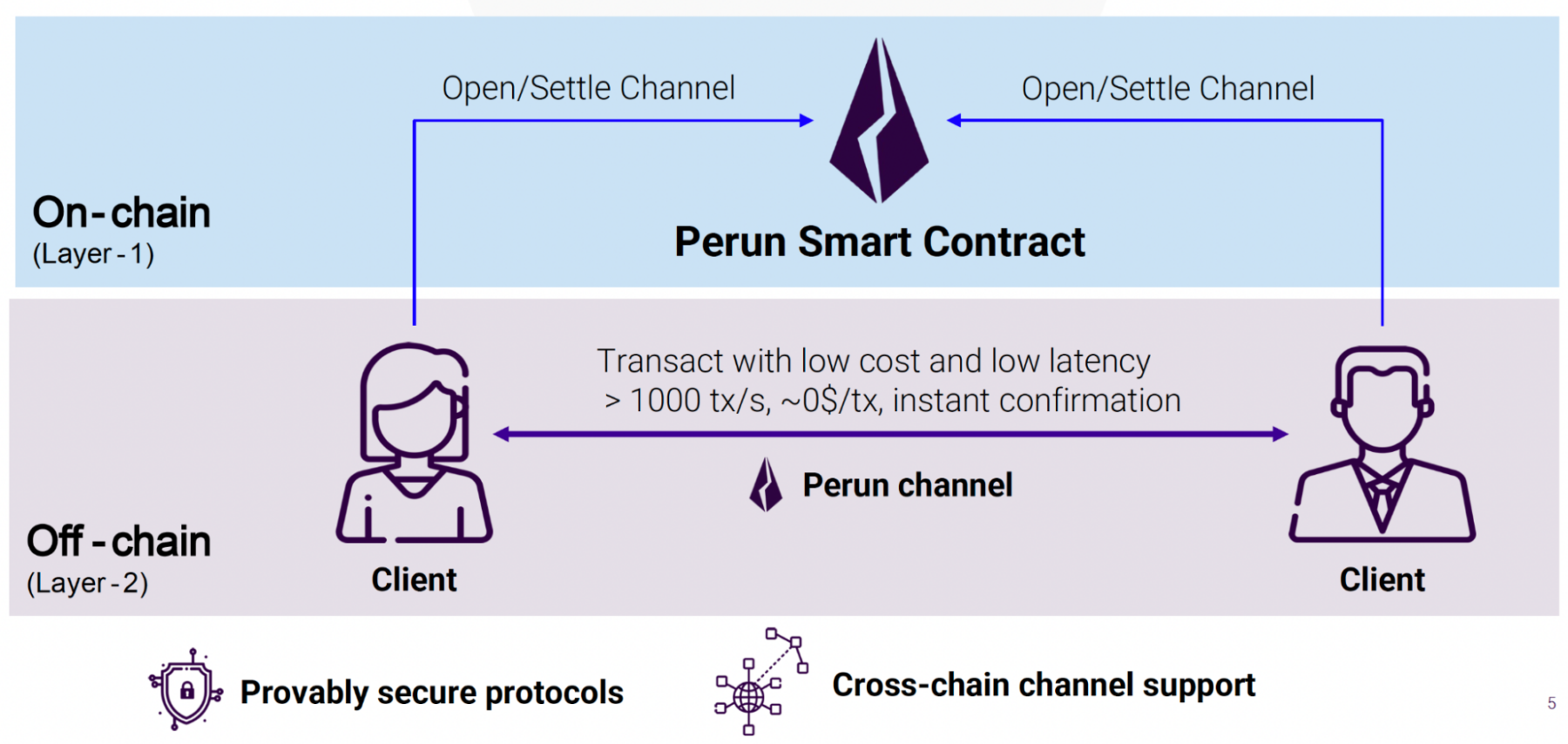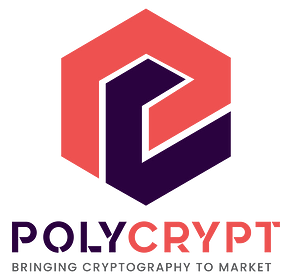Step-by-step process leads Bosch to Hyperledger Labs with Perun layer-2 protocol
Goals
- To implement a blockchain-agnostic layer-2 protocol that dramatically speeds up micropayments
- To follow the open source strategy developed at Bosch
Approach
- Identify a requirement
- Set goals
- Consider the terrain
- Build a partnership
- Pick a suitable license
- Use open source archetypes
Results
- In 2021, Perun was one of the top 10 most active Hyperledger Labs
- Perun demos run with Ethereum, Polkadot, and Cosmos blockchains
- Protocol can support payments with any cryptocurrency or CBDC
A step-by-step path to open source
How do you speed up a blockchain to support micropayments between things like sensors and devices?
That was the question for Bosch researchers exploring the Economy of Things, in which IoT devices will need to buy and sell to one another.
In 2017, the researchers came across Perun, an early layer-2 protocol that passes state information off-chain through virtual channels. Bosch joined forces with several academics to implement this protocol and start creating an ecosystem, using a step-by-step strategy for open source.
The project joined Hyperledger Labs in 2020, and the partners have now demoed Perun running with Ethereum, Polkadot, and Cosmos blockchains. The university spun off a new company, PolyCrypt GmbH, with funding from the German government.
Perun was one of 2021’s 10 most active projects in Hyperledger Labs with developers completing an SDK and a library for embedded devices. Perun is now available for anyone looking for a fast, proven protocol to support micropayments.
Step 1: Identify a requirement
Some years ago, IBM researchers realized that IoT devices would need to buy and sell from one another. In this “Economy of Things,” the items to be traded will include power, data, and connectivity. Most transactions will be fast, low value, and high frequency.
For a company like The Bosch Group that’s active in everything from autonomous vehicles to thermal plants, the Economy of Things will touch many lines of business. That’s why the company’s advanced research group, Bosch Research, was looking into the Economy of Things in 2017.
The first challenge was creating a secure platform to support automated micropayments between “things.” Naturally, this suggested distributed ledger technologies (DLTs) such as blockchain.
“We want to create a fair marketplace where everyone can participate, not a monopoly,” notes Chris Hoeppler, Open Source Officer for Bosch Research. “And we thought one of the technologies that might help would be DLTs.”
But blockchains don’t scale well. Reaching consensus on a transaction takes time. And tiny IoT devices have limited power, memory, processing, and connectivity. They certainly can’t run heavy code.
How could any blockchain possibly work around all these constraints? And how could Bosch help pioneer the standards needed for IoT devices to buy and sell among themselves?
“Reaping the benefits of open source investment requires nailing a series of difficult steps. When you approach open source with clear strategic intent, you maximize the chances that your efforts will get you what you’re looking for.”
Step 2: Set goals
The immediate business goal for Bosch was to find a way to scale up blockchain transactions to support the Economy of Things.
Beyond that, Bosch followed a step-by-step strategy for developing new markets using open source. This strategy was created with help from Open Tech Strategies (OTS), a consulting firm well versed in open source.
“Reaping the benefits of open source investment requires nailing a series of difficult steps,” says James Vasile, co-founder of OTS.
“These steps lead managers through practical analysis, from setting goals to gathering ecosystem information to identifying archetypes and adopting best practices. When you approach open source with clear strategic intent, you maximize the chances that your efforts will get you what you’re looking for.”
Hoeppler and Vasile drew up two open source goals for the project: to lead an effort to create standards for the Economy of Things, and to build a framework where different partners could work together.
“In the master plan for the Economy of Things, we think the lower level of the tech stack—the infrastructure—must be open source. The next layer protocols for transactions and sharing data sets should be common as well.”

“In the master plan for the Economy of Things, we think the lower level of the tech stack—the infrastructure—must be open source,” notes Hoeppler, as shown in the diagram.
“The next layer protocols for transactions and sharing data sets should be common as well, with no monopoly of any type.
“And on top of that are the proprietary layers with agents, apps, and products, where we all compete.”
In other words, Bosch will gladly cooperate with other stakeholders to develop digital platforms and marketplaces, and then compete on those platforms by offering specific products and services: a textbook definition of “coopetition.”
Step 3: Consider the terrain
The next step for Hoeppler and his team was to survey the landscape for likely partners.
This led them to Professors Stefan Dziembowski from the University of Warsaw and Sebastian Faust from the Technical University Darmstadt in Frankfurt. Their 2017 paper “Perun: Virtual Payment Hubs over Cryptocurrencies” offered mathematical proof for a secure way to speed up blockchain transactions. This novel approach used virtual channels to exchange state information off-chain, an early example of what’s now called a “layer-2 protocol.”
Nothing is written to the blockchain until one party uses up all their reserved funds, something like spending all the credit on a gift card. So this method can settle micropayments in milliseconds.
“Perun” was named for a Slavic god who rules thunder and lightning, a witty reference to the Lightning Network started about the same time.
In 2018, Hoeppler contacted the academics to propose they work together. At the time, says Professor Faust, they were getting emails from Ethereum followers who wanted to invest in their idea.
But they talked to Bosch instead.
Step 4: Build a partnership
A handful of academics on one side and a giant multinational on the other: What could go wrong? But the early meetings were positive, and the breakthrough idea pulled the two teams together.
“They had a small lab that looked more like a university where they’d built some kind of demo. We thought it makes sense to collaborate,” recalls Professor Faust. “And, in my opinion, it’s been a very nice collaboration, very smooth.”
Negotiations between the universities and the company were done by mid-2018 and then the real work began. Eventually, of course, there were technical challenges.
Two different codebases were created, one at Bosch and another at the university. After some debate, both partners settled on a single codebase.
The initial implementation and the SDK were released in 2019, and the first Perun node was running early in 2020. But Perun still needed a stable home where everyone could access the latest code, and other people could find it.
Step 5: Pick a suitable license
“Licenses matter less than most people think,” notes Vasile. “They’re rarely enforced in courts, haphazardly interpreted, and differ from each other in relatively minor ways.”
He says the most important factors in choosing a license are not the legal terms, but the community and how partners work together. And besides, where your project resides often determines the license you must use.
Hoeppler says they considered the Eclipse Foundation where Bosch was already active. And the professors wondered about the Ethereum Foundation.
But since Perun was conceived as blockchain-agnostic, the Hyperledger community looked like a better fit. Hyperledger Labs provides a space where developments can be started without the overhead of creating an official Hyperledger project. That makes an ideal repository for experiments or codebases like Perun that hadn’t been fully realized with production-ready features, complete documentation, and a thriving community.
“In the beginning, we were not sure, because we were very close to Ethereum. But in the end, I think it was a good choice to put Perun into Hyperledger Labs.”
“In the beginning, we were not sure, because we were very close to Ethereum,” says Professor Faust. “But in the end, I think it was a good choice to put Perun into Hyperledger Labs because it’s an independent organization.”
Bosch was already a member of the Hyperledger Foundation. Hoeppler pitched the idea to then-director of ecosystem Marta Geater-Piekarska, who put him in touch with the right contacts and encouraged everyone to move forward.
In Q3 2020, the project was welcomed into Hyperledger Labs with help from long-time community contributor and lab steward Tracy Kuhrt. The project was sponsored by IBM’s Arnaud J Le Hors, then chair of the foundation’s Technical Steering Committee.
And its Apache 2.0 open source license suited everyone.
That license worked for the university when it spun off a startup to carry on the development. And it was fine with the German Ministry of Education and Research, who awarded a major grant to the new company, PolyCrypt GbmH.
Step 6: Use open source archetypes
A final step in the Bosch process was to draw inspiration from classic open source projects.
The archetypal projects seen in the past 20 years are described in an illuminating paper written by OTS for Mozilla Corporation.
Many archetypes have colorful names like Bathwater, Single Maintainer Houseplant, and Rocket Ship to Mars. Each has certain tendencies that people can look for in their own projects.
The goal isn’t to pick one archetype and follow a simple checklist. The value of this step is to find questions to ask, patterns to watch for, and directions to work towards.
“Most open source projects fit one of these archetypes better than any other,” notes Vasile. “Very few projects fit one single archetype perfectly.”
And many open source projects evolve over time.
For example, Hoeppler says the Perun project started out as a Rocket Ship to Mars: a small, full-time team focused on the very specific goal of implementing the Perun protocol.
Now he’d like it to evolve to a Multi-Vendor Infrastructure that supports a wide array of other businesses in the Economy of Things.
“Hyperledger is a watering hole where a lot of people gather. The benefit for Perun is access to the community’s constellation of interested parties, like-minded collaborators who can accelerate their development and market reach.”
The next step: Reaching more partners through Hyperledger Labs
“Hyperledger is a watering hole where a lot of people gather,” says Vasile.
“The benefit for Perun is access to the Hyperledger community’s constellation of interested parties. It’s a place to look for like-minded collaborators, finance industry partners who can accelerate their development and market reach.”
He says a sure sign of success will be another industry player getting involved in a big way.
“That’s somebody showing up with the resources to productize the work and saying, ‘We’re going to include this in something that will be in front of millions of people.’ To me, that’s the big moment. And I would love it if Hyperledger were the place that got Perun over the hump.”
Anyone who wants to learn more about Perun can visit the Hyperledger project page here or the Github here.
We never know what technology will turn into the Next Big Thing.
Perhaps Perun will be one of them, powering billions of micropayments between IoT devices or enabling people to shop with CBDCs that are still on the drawing board today.
In any case, a step-by-step open source strategy has now made Perun available to anyone anywhere through Hyperledger Labs.
Scaling with Perun’s blockchain-agnostic state channels

About The Bosch Group
The Bosch Group is a leading global supplier of technology and services. Bosch improves quality of life worldwide with products and services that are innovative and spark enthusiasm. In short, Bosch creates technology that is “Invented for life.”
The Bosch Group comprises Robert Bosch GmbH and its roughly 440 subsidiary and regional companies in some 60 countries. With more than 400 locations worldwide, the Bosch Group has been carbon neutral since the first quarter of 2020. At 129 locations across the globe, Bosch employs some 73,000 associates in R&D, of which nearly 34,000 are software engineers.
To learn more, visit www.bosch.com

About PolyCrypt
As a spin-off of the Technical University of Darmstadt, PolyCrypt builds decentralized software and infrastructure and consults businesses in leveraging innovative blockchain technology. The team is highly interdisciplinary and includes blockchain developers, researchers, cryptographers, financial exchange experts, and more.
By building trustless technology Polycrypt is able to open up blockchain systems for businesses as well as end-users and can realize the true power of decentralization: bringing privacy, scalability and user freedom to everyone.
To learn more, visit https://polycry.pt
About Hyperledger
Hyperledger Foundation was founded in 2015 to bring transparency and efficiency to the enterprise market by fostering a thriving ecosystem around open source blockchain software technologies. As a project of the Linux Foundation, Hyperledger Foundation coordinates a community of member and non-member organizations, individual contributors, and software developers building enterprise-grade platforms, libraries, tools, and solutions for multi-party systems using blockchain, distributed ledger, and related technologies.
To learn more, visit https://www.hyperledger.org/
Sign up for the monthly Hyperledger Horizon & /dev/weekly newsletters
By signing up, you acknowledge that your information is subject to The Linux Foundation's Privacy Policy